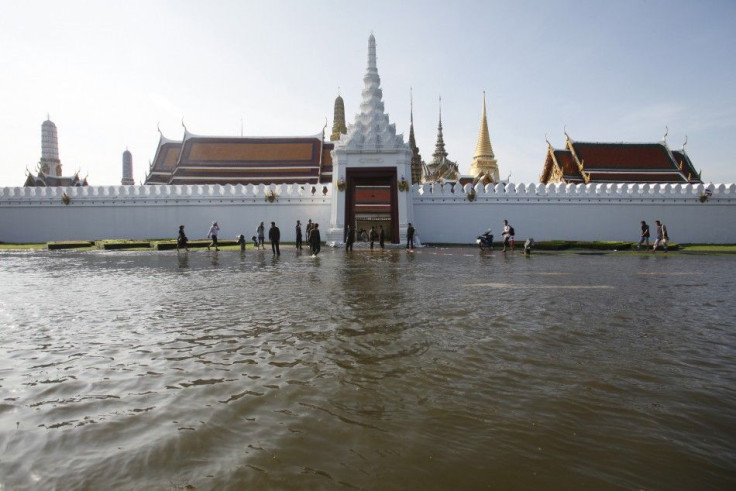Bangkok Flooding 2011: Latest Info on Travel to Thailand

2011 is turning out to be a rough year for Bangkok as severe flooding continues to put a damper on the city's all-important tourism industry.
The flooding in Thailand has cost the nation dearly, and the situation for would-be travelers is as confusing as ever.
Government statements oscillate between cataclysmic warnings and friendly assurances; meanwhile the international media, travel agents, and hotel proprietors offer conflicting reports - all of which leaves both the people of Thailand and prospective tourists utterly perplexed.
To date, the floods have inundated about one-third of the country, affecting over three million people and killing over 500 nationwide since the disaster began at the end of July. Unsurprisingly, the reports are conflicting over how high the waters will rise in the coming weeks.
For now, the central shopping district remains relatively dry, but tourists have all but disappeared from the streets of central Bangkok.
Decline in Tourism Numbers
Tourism is a vital part of Thailand's economy, employing about 15 percent of the workforce and contributing about six percent of the GDP.
The Governor of the Tourism Authority of Thailand (TAT), Suraphon Svetasreni, said the projected losses comprise $387 million from international tourism and $438 million from domestic tourism.
However, Svetasreni said the losses could be trimmed back substantially if the crisis is resolved by the end of the month and international travelers are aware of the actual facts about the flooding.
Most of central Bangkok where tourists normally go to such as Khao San Road, Ratchprasong Intersection, Sukhumvit Road, Silom and Sathorn are not flooded, he said in a statement.
Svetasreni also said he wants the international community to know that much of the country is not underwater, including popular tourist destinations such as Chiang Mai, Pattaya, Phuket, Krabi, Phan-Nga, and Koh Samui.
Svetasreni is confident that with an effective marketing campaign tourist arrivals will bounce back once the crisis over, just like they have during past natural disasters, epidemics, and times of political unrest.
Suvarnabhumi Airport
Passenger numbers at Bangkok's main Suvarnabhumi Airport began a steady decline at the end of October, falling seven percent on last year's numbers as nations from the U.S. to New Zealand issued travel warnings for the region. As the floods increased, that number dropped to 25 percent in early November.
The drop reflects a move by airline executives to slice the number of flights through Bangkok, a process that began at the end of October.
Before the floods, Bangkok's Suvarnabhumi handled roughly 130,000 passengers on an average of 800 flights per day.
Now, that number is rapidly declining.
Cathay Pacific reportedly halved its Bangkok-Hong Kong service to two flights a day. Meanwhile, Thai Airlines has suspended its daily flight on the same route (which typically filled a Boeing 747 jet).
Both airlines are pondering cutting back services on several regional routes to locations like Colombo and Hat Yai.
Meanwhile, Bangkok's other airport, Don Muaeng, remains closed due to the flooding.
Travel Outside of Bangkok
The closure of Don Mueang airport has had little effect on domestic flights within Bangkok. The two domestic airlines operating from that airport have temporarily switched their operations to Suvarnabhumi, with flights accommodated on a normal schedule.
The State Railway of Thailand (SRT) and inter-provincial bus services are operating as per usual in areas that are not affected by the floods. Inter-provincial buses from Bangkok to southern provinces leave from a temporary station with shuttle services to and from the Southern Bus terminal, also known as Sai Tai Mai. Train services to northeastern Thailand operate as per normal. Train services to the northern provinces operate between Hua Lamphong station in central Bangkok and Chiang Mai. Trains to the north are rerouted around flooded areas.
A search online for hotel rooms at popular Thai resorts shows that numbers are actually up outside of Bangkok as people flee the city. Consequently, it may be difficult to find accommodations in places like Pattaya and Hua Hin. Furthermore, the resorts are reportedly running low on some supplies.
The Situation on the Ground in Thailand
While many are concerned about getting into and around Thailand, there's a series of potential problems facing travelers once they set foot in the Land of Smiles.
There's a shortage of bottled water, staple foods and items like toilet paper because major supermarkets and wholesale distribution centers are under water. There are also concerns of health and food safety with the waste-filled floodwaters.
However, Srisuda Wanapinyosak, Director of Tourism Authority of Thailand's (TAT) U.S. Branch in New York, assured that Thailand is open for business.
Hotels in the unaffected areas of Bangkok maintain a large inventory of supplies, so tourists will be able to get food and bottled water as per usual, Wanapinyosak told IBTimes.
The TAT director also played down any health risks, saying that health concerns apply only to those who have experienced the effects of being in standing water in flooded areas for prolonged periods.
Tourists who are not in flooding areas will not experience any such health concerns, Wanapinyosak said.
Wanapinyosak wanted to send a strong message to prospective travelers:
Oh behalf of TAT, we're seeking to correct misperceptions about tourist destinations in Thailand, noting that the flooding has mainly impacted the provinces along the Chao Phraya River, including parts of Bangkok and Ayutthaya, but that the vast majority of Thailand's most popular destinations to the north and south have had no flooding whatsoever and remain dry.
Wanapinyosak said it's very important for people to have a clear picture and rest assured that they can plan their trip and know that they will have a world-class experience when they arrive in Thailand.
For more information and current updates on the flooding situation, travelers can visit www.thailandtourismupdate.com.
© Copyright IBTimes 2024. All rights reserved.






















